Encoder Pulse Distribution Modules
Differential ABZ | Single-ended ABZ | Pulse+Direction
Signal distribution modules receive Pulse+Dir or ABZ encoder signals and replicate them into multiple isolated outputs.
They enhance signal strength, reduce interference, and maintain accurate synchronization across multiple controllers or drives.
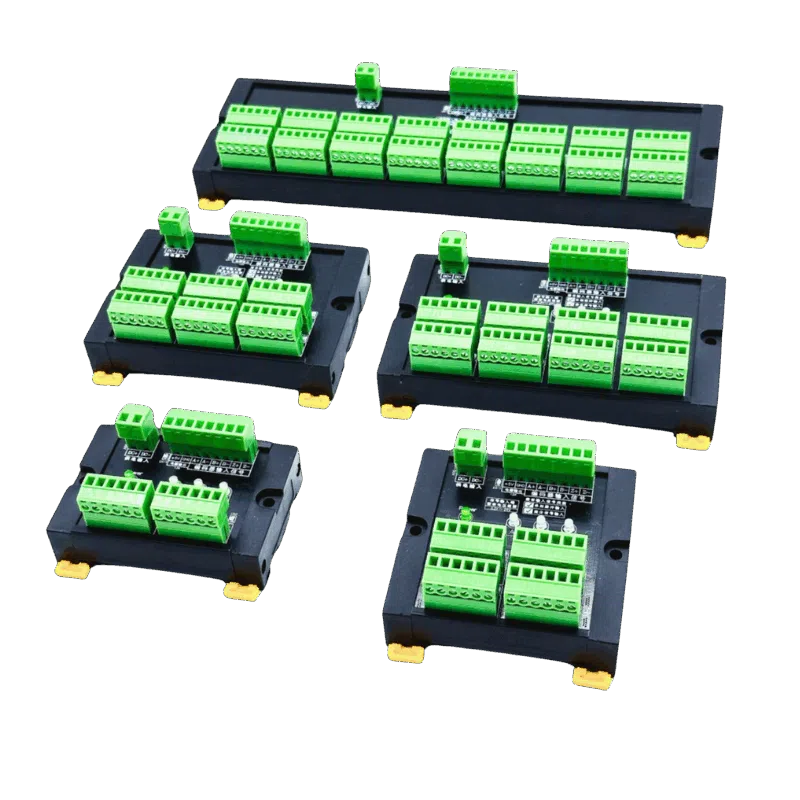
Signal distribution modules are designed to duplicate and amplify motion control or encoder feedback signals.
They allow one input — either Pulse+Direction or ABZ encoder signals — to be shared across multiple drives, PLCs, or controllers with consistent timing and stability.
This ensures precise synchronization, reduces wiring complexity, and enhances reliability in automation systems.
💡 In simple terms: one signal input → multiple clean, isolated outputs for accurate control or feedback.
| Type | Modèle | Signal Input | Output Format | Caractéristiques principales |
|---|---|---|---|---|
| ■ Pulse + Direction | EJ-XPUD | Pulse / Dir | TTL or 24 V | Multi-axis synchronization, clean timing |
| ■ ABZ Differential | EJ-XABZ | A+/A−, B+/B−, Z+/Z− | RS-422 | Long-distance, anti-interference |
| ■ ABZ Single Ended | PN-XABZ | A, B, Z (common GND) | NPN / PNP / TTL | Easy wiring, compact & economical |
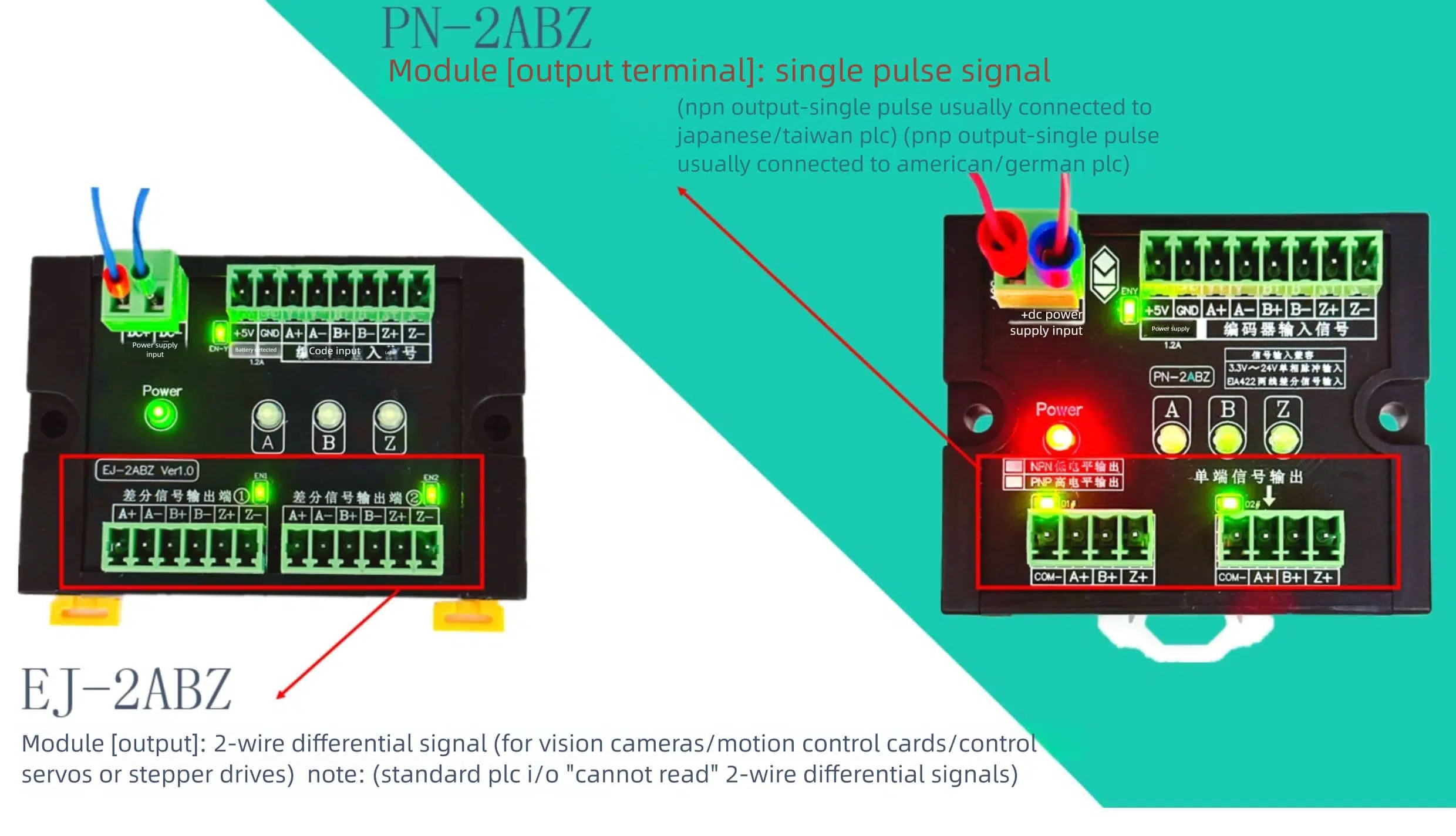
Each module serves a distinct role — choose Pulse+Dir for motion control output, Differential ABZ for encoder feedback over long distances, or Single-ended ABZ for simple, short-range applications.
Le ABZ Differential Output Module is designed to distribute and amplify encoder signals (A, B, Z phases) in differential form (A+/A−, B+/B−, Z+/Z−).
It allows one encoder input to be shared with multiple devices — such as PLCs, motion controllers, or servo drives — without signal distortion or delay.
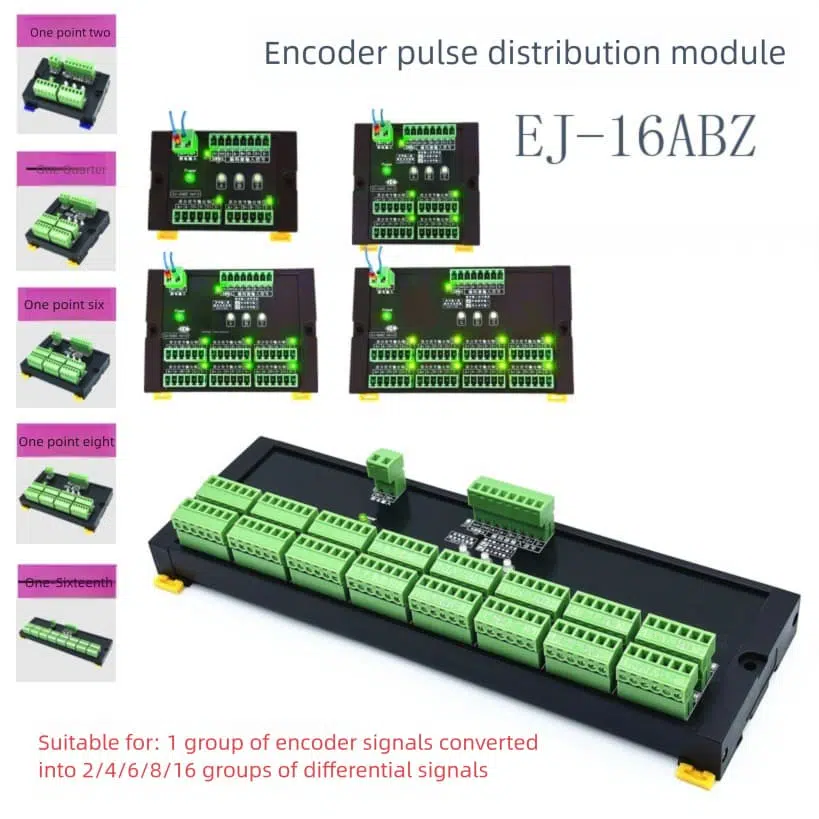
By using RS-422 standard outputs, this module ensures long-distance, noise-resistant, and phase-accurate signal transmission.
In simple terms: one encoder → multiple clean RS-422 outputs for reliable feedback communication.
The input receives differential encoder signals (or converts single-ended ABZ into differential form internally).Each output channel is buffered and isolated to prevent signal attenuation and crosstalk.The built-in driver circuits regenerate the pulse edges and maintain precise phase alignment even under long cable runs.

Signal Flow Example:
Encoder → Input (A+/A−, B+/B−, Z+/Z−) → Distribution → 4/6/8/16 RS-422 Outputs
Electrical Standard: RS-422 / TTL Compatible
Typical Distance: up to 100 meters
| Paramètres | Spécifications |
|---|---|
| Input Signal | Differential ABZ (RS-422 / TTL) |
| Output Signal | Differential ABZ (A+/A−, B+/B−, Z+/Z−) |
| Output Channels | 4 / 6 / 8 / 16 |
| Power Supply | DC 9–30 V |
| Output Standard | RS-422, TTL compatible |
| LED Indicators | Signal & Power status per channel |
| Température de fonctionnement | −20°C ~ +60°C |
| Montage | DIN rail / panel mount |
✅ 1 input → up to 16 differential outputs
✅ RS-422 / EIA422 compatible, high anti-interference
✅ Each channel with LED signal indicators
✅ Supports wide voltage range (DC 9–30 V)
✅ Pluggable terminal blocks, easy maintenance
✅ Stable performance in harsh industrial environments
Le ABZ differential output module series is available in multiple versions to meet various industrial requirements — from compact 4-channel units to large 16-channel signal distribution boards.
All models share the same design philosophy: stable RS-422 output, high-speed signal integrity, and excellent anti-interference performance.
These modules are widely used in motion control systems, servo feedback circuits, and PLC encoder input distribution,
| Modèle | Input Type | Output Channels | Recommended Application |
|---|---|---|---|
| EJ-2ABZ | 1 × Differential ABZ | 2 | Ideal for encoder signal duplication in small servo systems |
| EJ-4ABZ | 1 × Differential ABZ | 4 | Ideal for compact CNC machines or small motion platforms |
| EJ-6ABZ | 1 × Differential ABZ | 6 | For PLC encoder feedback and mid-size automation systems |
| EJ-8ABZ | 1 × Differential ABZ | 8 | Standard model for servo motor feedback distribution |
| EJ-16ABZ | 1 × Differential ABZ | 16 | High-density industrial controller synchronization module |
💡 All models feature pluggable terminal blocks, LED status indicators, and DIN-rail mounting for easy installation and maintenance.
Choosing a differential signal output module brings significant advantages over single-ended types,
especially in high-speed, long-distance, and noise-prone industrial environments.
✅ Key Technical Advantages
💡 Example Use Cases
📈 In summary, differential output modules are essential for engineers who need high-speed, interference-free signal distribution in industrial automation.
If your project involves encoder feedback, servo control, or multi-axis synchronization, differential ABZ output modules offer the most stable and precise performance.
They are compatible with major industrial controllers such as Siemens, Mitsubishi, Omron, Delta, and Beckhoff PLCs.
ABZ Single-ended Output Module is designed to distribute standard A/B/Z encoder signals in TTL, NPN, or PNP levels.
It allows one encoder input to be shared with multiple PLCs, counters, or motion controllers where short-distance signal transmission and cost-efficiency are required.
By providing clean, buffered single-ended outputs, this module simplifies wiring and ensures consistent logic levels for accurate feedback detection.
Simple, compact, and economical — ideal for short-range signal distribution in automation systems.
The module receives ABZ signals 24 V NPN/PNP from an encoder, buffers and isolates them internally, and replicates several identical single-ended outputs.
It supports three standard signal input types so users can connect according to their PLC’s I/O mode: Differential, NPNou PNP.
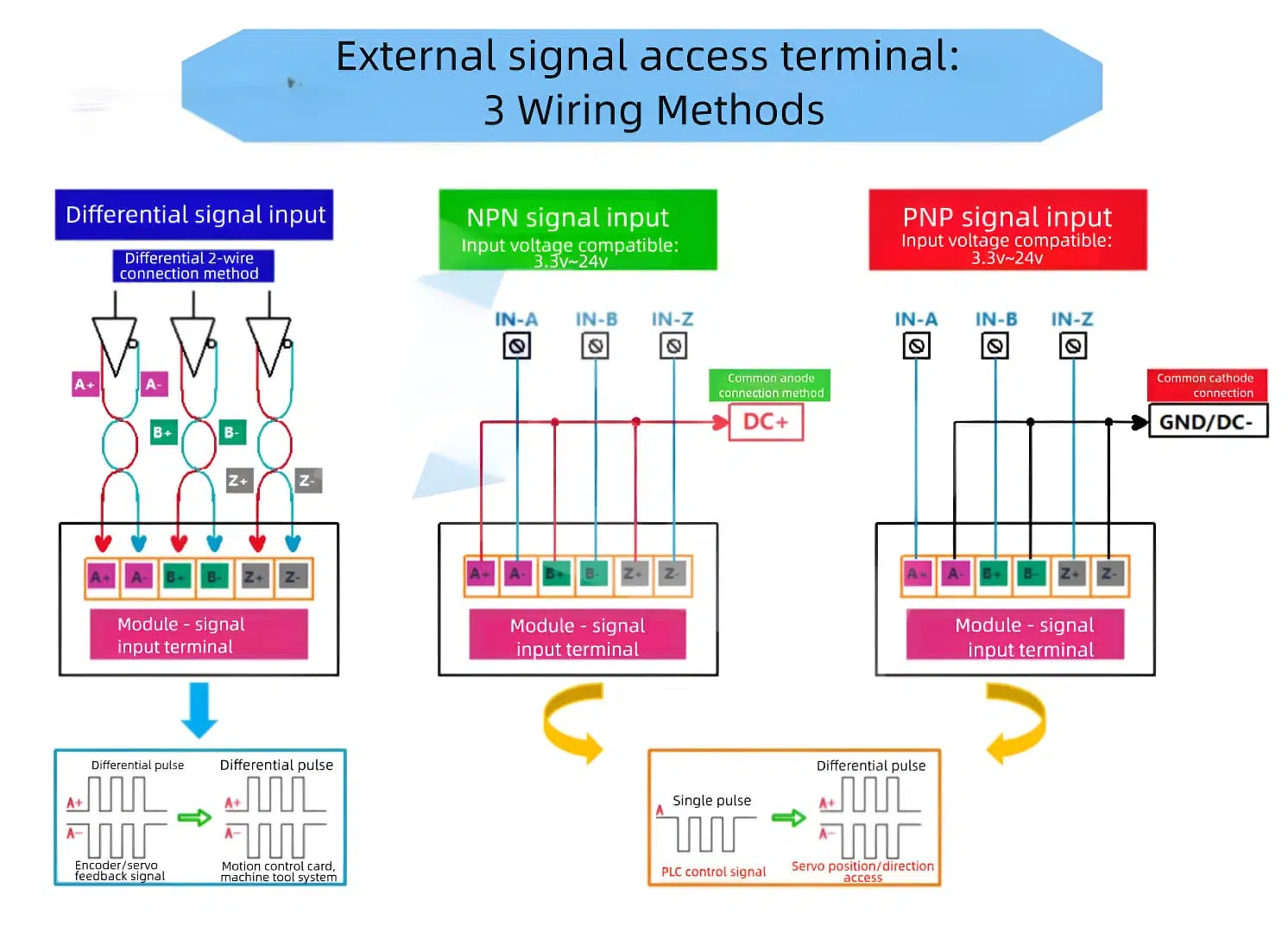
En NPN mode, the COM terminal connects to DC+, and the signal is low-level active (0 V).
This is commonly used with Japanese controllers such as Omron, Mitsubishi, and Panasonic.
Both modes are isolated and buffered internally, ensuring accurate and noise-free feedback.
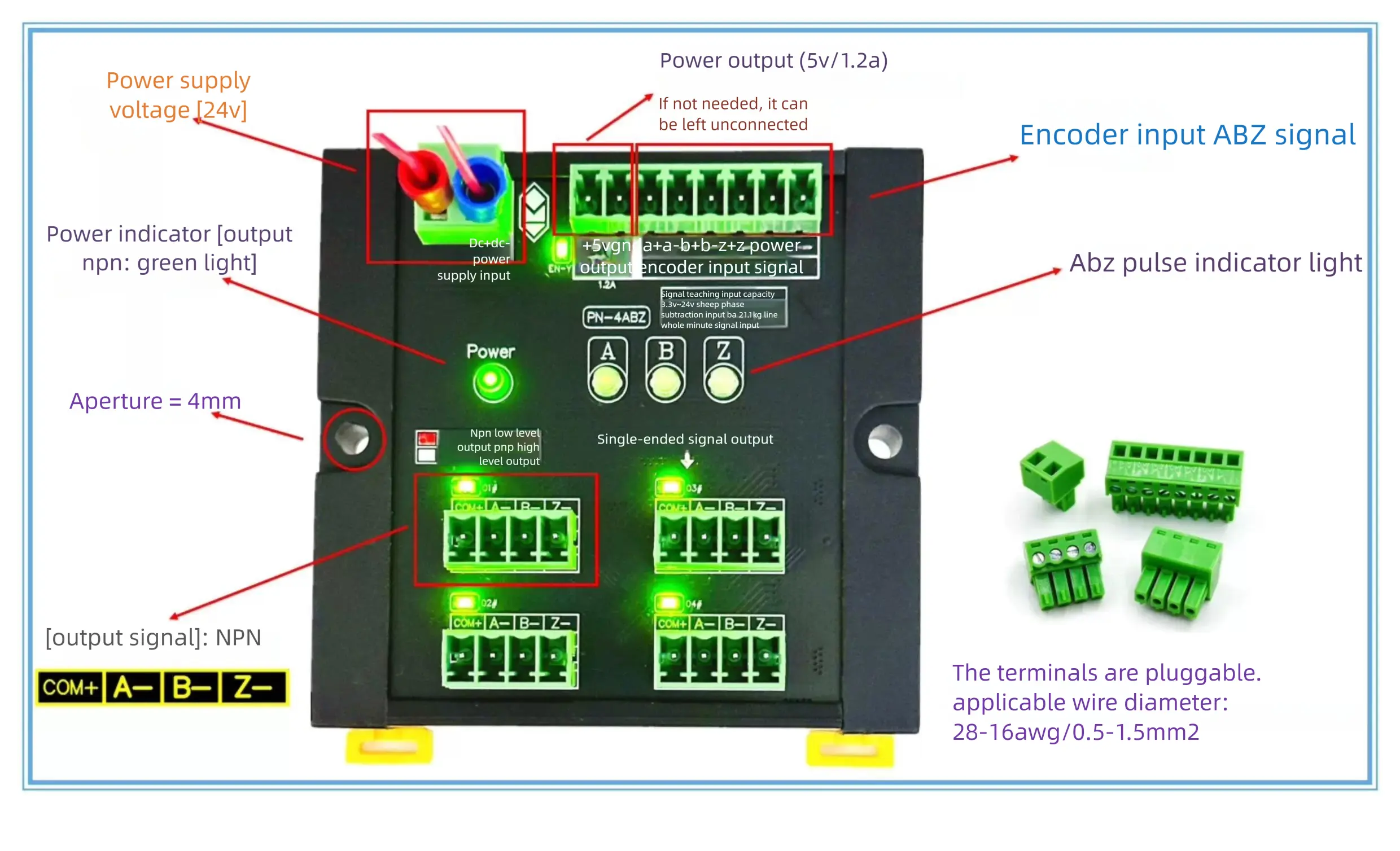

In PNP mode, the COM terminal connects to DC−, and each channel outputs a 24 V high-level signal when active.
This configuration suits European controllers such as Siemens or Beckhoff PLCs.
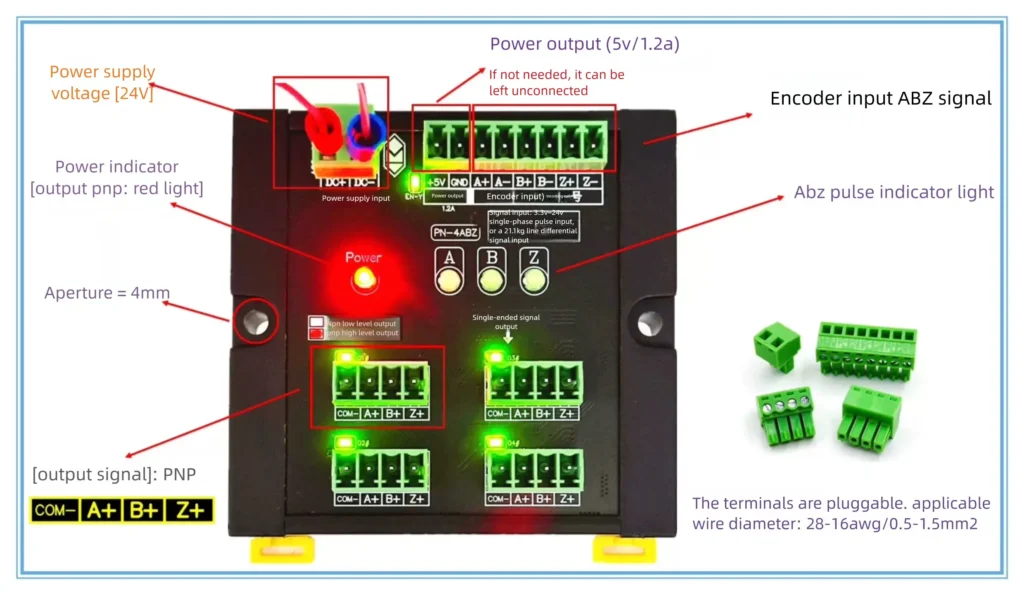
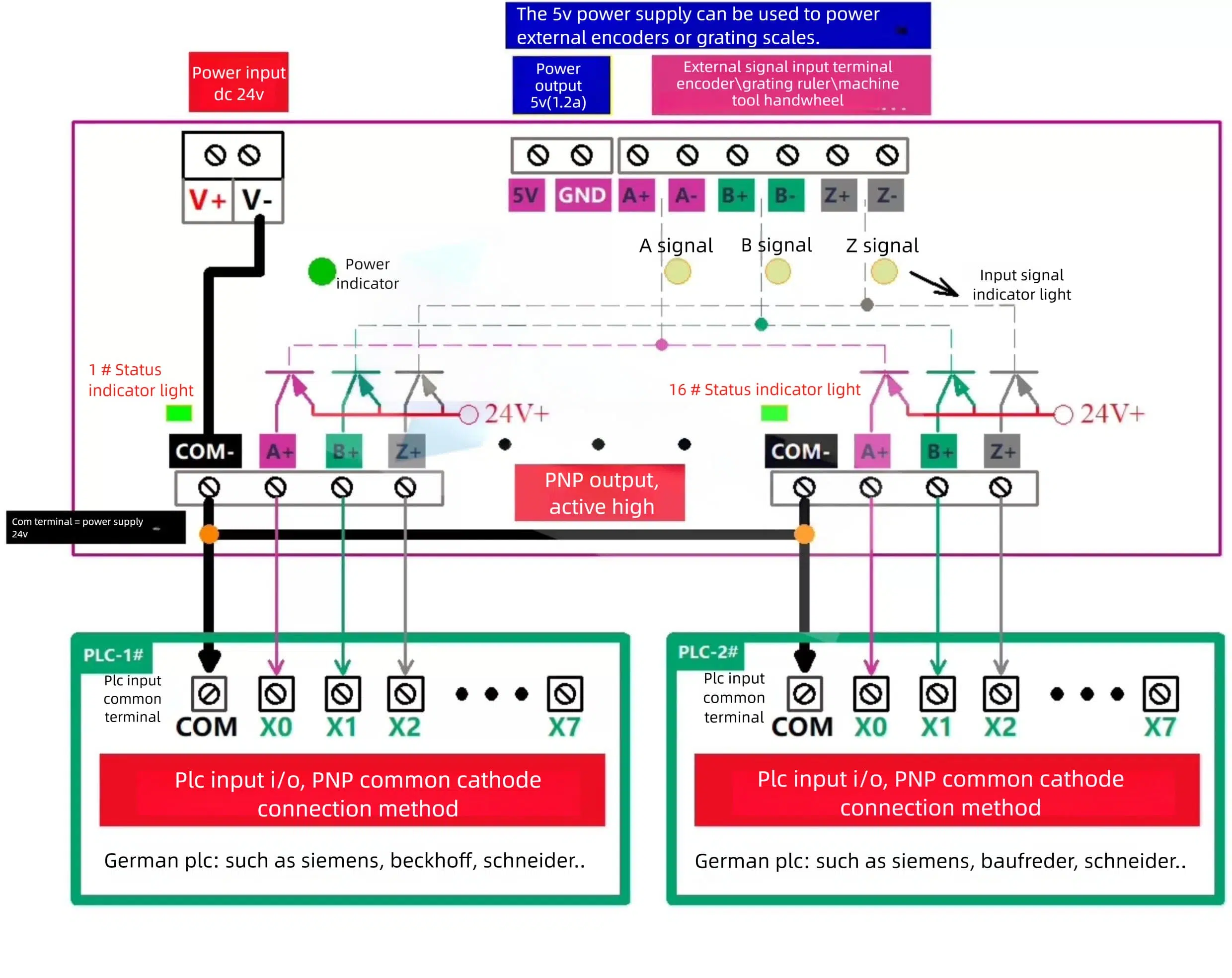
These modules are widely used in small automation machines, packaging lines, robotic arms, and testing benches where simple encoder signal expansion is needed.
All single-ended models share the same core circuit and differ only by channel count.
| Modèle | Output Channels | Output Level | Power Supply |
|---|---|---|---|
| PN-2ABZ | 2 | TTL / NPN / PNP | DC 9–30 V |
| PN-4ABZ | 4 | TTL / NPN / PNP | DC 9–30 V |
| PN-6ABZ | 6 | TTL / NPN / PNP | DC 9–30 V |
| PN-8ABZ | 8 | TTL / NPN / PNP | DC 9–30 V |
Avantages :
Discover how single-ended ABZ modules can simplify signal distribution in your automation system.
Download the product datasheet or contact our engineers for model recommendations.
Le Pulse + Direction Distribution Module series (EJ-xxPUD) is designed to split and amplify PUL/DIR control signals from a single motion controller into multiple synchronized outputs.
Disponible en 2, 3, 4, 6, 8, 16, and 32-channel versions, the series supports both stepper and servo motor drives, allowing multiple axes to move in perfect synchronization.

Each module receives standard pulse and direction inputs (5 – 24 V) and replicates them into optically isolated, high-speed outputs — ideal for CNC systems, pick-and-place robots, packaging lines, and linear motor platforms.
This series adopts a unified circuit design featuring:.
he Pulse + Direction Distribution Module series adopts a unified signal architecture that receives one set of PUL (pulse) et DIR (direction) signals from a motion controller or PLC, then reproduces and amplifies them across multiple isolated output channels.
Each channel delivers a clean, time-synchronized copy of the original signal, ensuring that all connected stepper or servo drives move simultaneously with identical accuracy.
Internally, the modules use photoelectric isolation to separate control and output circuits.
This prevents interference, voltage surges, or ground loops from affecting the controller, providing stable operation even in high-noise industrial environments.

Structural highlights:
The modules support both single-ended (TTL) et differential (RS-422 / EIA-423) inputs, automatically adapting to signal types from most motion controllers and PLC systems. All output channels are fully buffered and capable of driving long cables or multiple drive inputs without signal degradation.
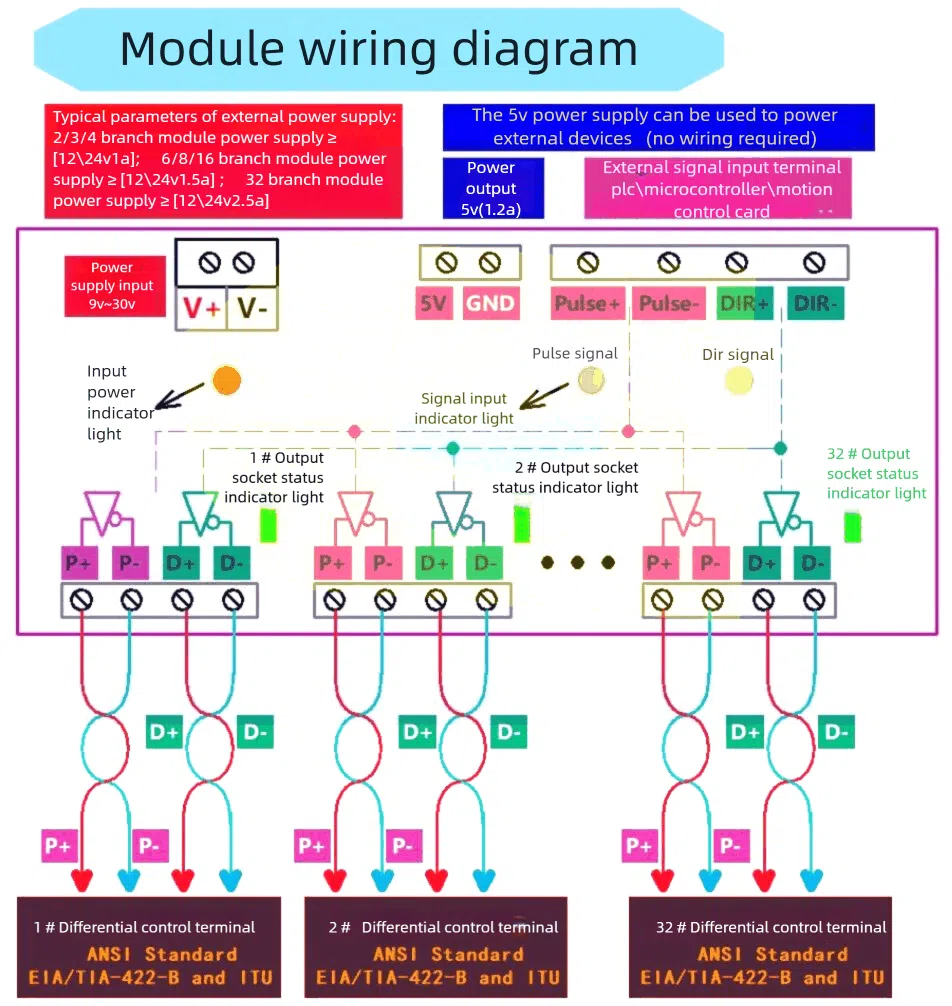
The EJ-XPUD supports both single-ended (TTL) et differential (EIA-422/423) input signals, ensuring compatibility with different PLC or controller types.
It is widely used in:
The photoelectric isolation and buffer design allow stable operation even under electrical noise or ground potential differences.
The Pulse + Direction Distribution Module series includes a full range of channel configurations — from 2-channel up to 16-channel — designed to match different levels of motion control systems.
Each model converts one input set of AB (pulse + direction) signals into multiple identical outputs, maintaining perfect signal consistency and isolation across all channels.
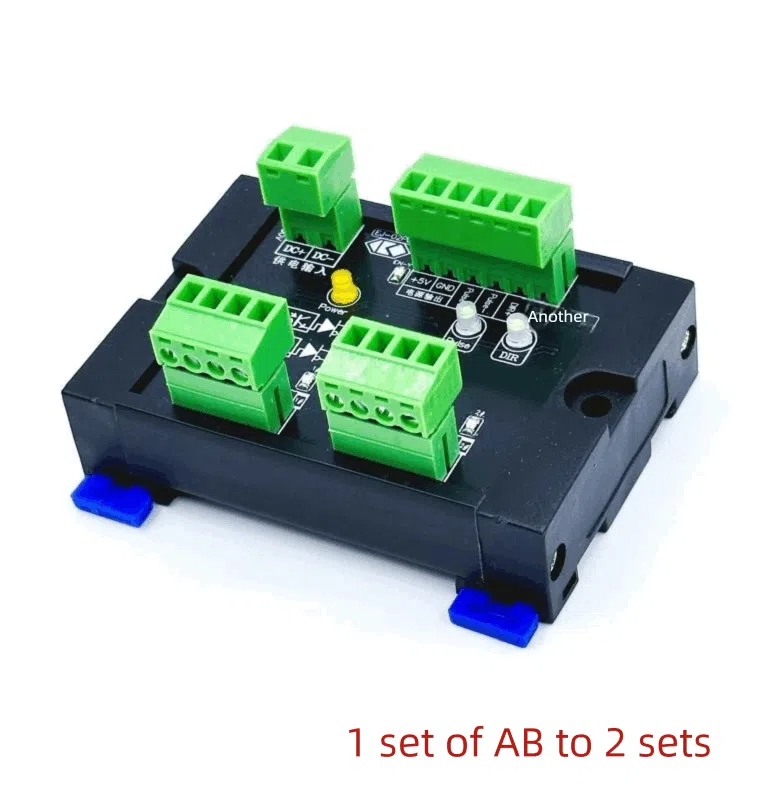
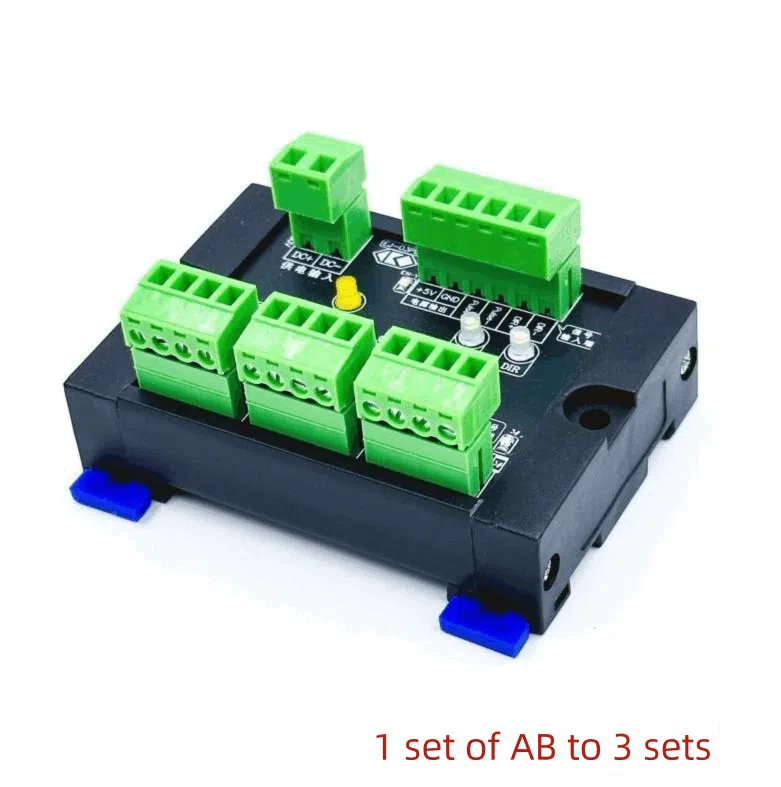
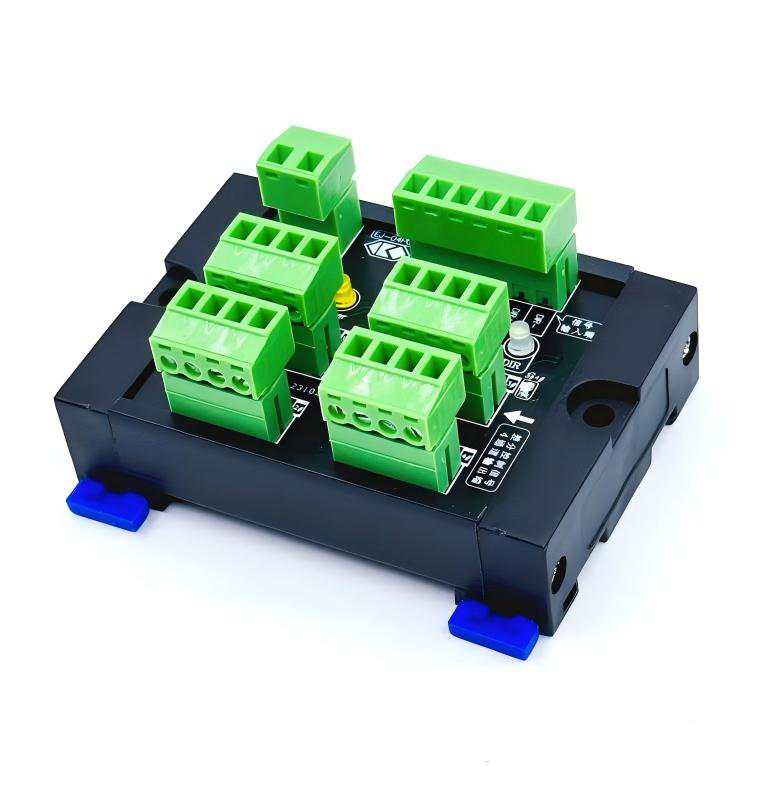

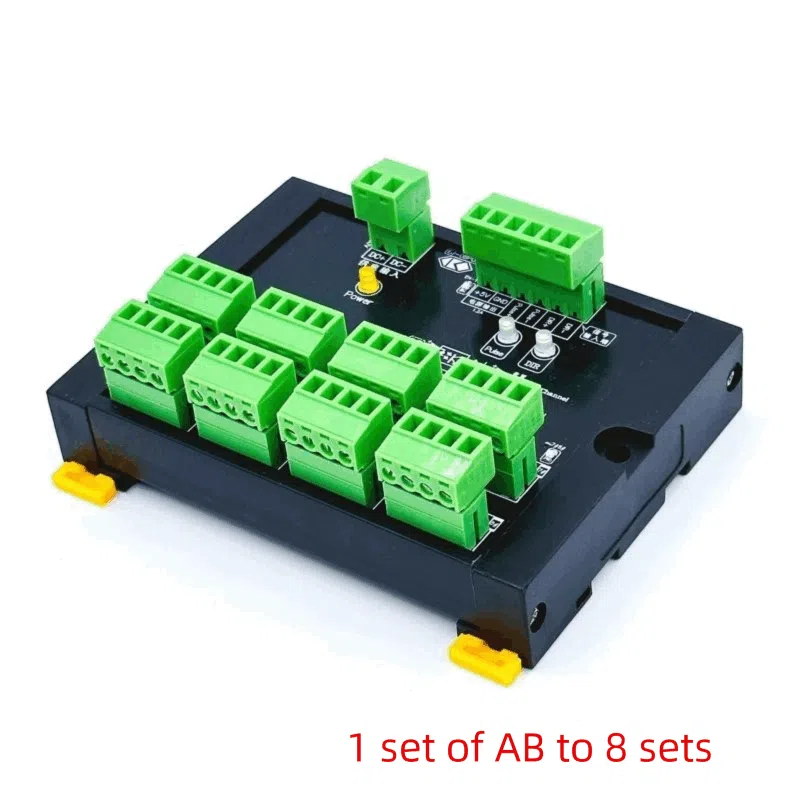
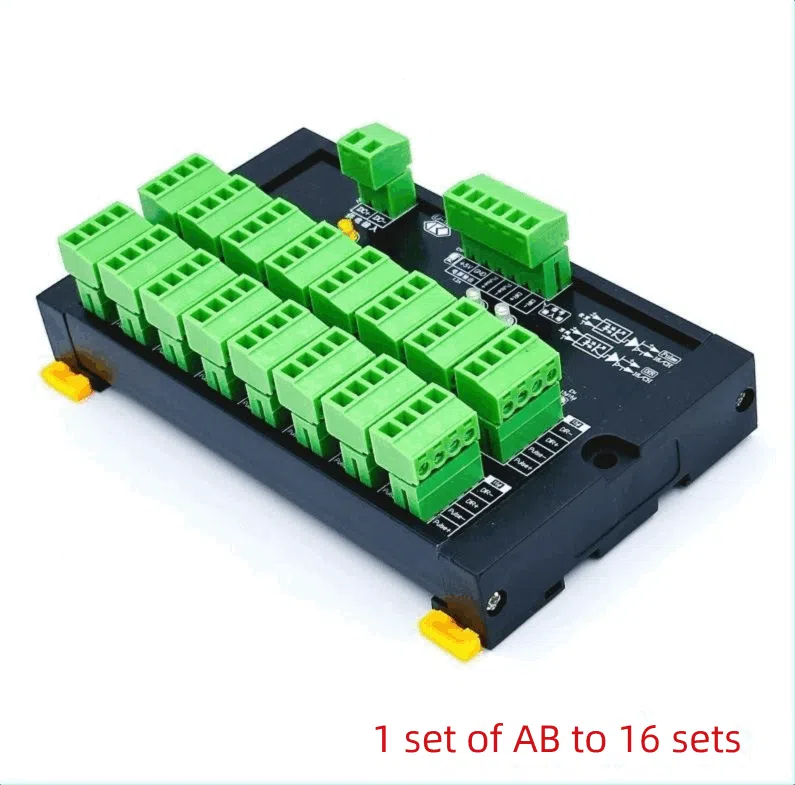
| Modèle | Conversion | Size (mm) | Mounting Hole |
|---|---|---|---|
| EJ-02PUD | 1 → 2 AB | 78×59×36 | Ø4 mm / 70 mm |
| EJ-03PUD | 1 → 3 AB | 78×59×36 | Ø4 mm / 70 mm |
| EJ-04PUD | 1 → 4 AB | 78×59×36 | Ø4 mm / 70 mm |
| EJ-06PUD | 1 → 6 AB | 77×81×36 | Ø4 mm / 69 mm |
| EJ-08PUD | 1 → 8 AB | 104×81×36 | Ø4 mm / 95 mm |
| EJ-16PUD | 1 → 16 AB | 131×81×36 | Ø4 mm / 123 mm |
All models share the same electrical characteristics:
Avantages :
Enhance your motion control system with EJ-XPUD Pulse Distribution Module — the ideal solution for precise signal splitting and stable multi-axis control.
Functional Comparison
Each series of signal distribution modules serves different industrial applications — all designed to ensure precise synchronization, electrical isolation, and stable signal replication.
| Fonctionnalité | Pulse + Direction Module | ABZ Differential Output Module | ABZ Single-ended Output Module |
|---|---|---|---|
| Signal Type | Pulse (PUL) + Direction (DIR) | Encoder ABZ differential signal | Encoder ABZ single-ended signal |
| Input Compatibility | TTL / RS-422 / RS-423 | Differential encoder (EIA-422/485) | TTL, NPN, or PNP encoder signal |
| Output Type | Multiple PUL + DIR channels | Differential A+, A-, B+, B-, Z+, Z- | Single-ended A+, B+, Z+ |
| Isolation | Photoelectric isolation per channel | Photoelectric isolation | Photoelectric isolation |
| Typical Frequency | 3MHz | 200kHz–3MHz | 200kHz–3MHz |
| Typical Use | Motion controllers driving multiple servo/stepper axes | Encoder feedback sharing for servo positioning | Encoder feedback distribution to PLCs or counters |
Application Overview
Selection Guide
1️⃣ Based on Signal TypeSelect the model according to how many drives or PLC inputs you need to control or monitor:
The three module series ensure stable, isolated, and scalable signal distribution: Pulse + Direction for multi-axis motor control, ABZ Differential for encoder feedback with high noise immunity, and ABZ Single-ended for PLC input. All feature optical isolation, high-speed response, and pluggable terminals for reliable industrial automation.
Ask for your free sample or technical quote now.
A signal distribution module is a device that replicates and isolates control or encoder signals, such as pulse, direction, or ABZ, for multiple motor drives or PLC inputs in automation systems.
Yes, as long as your PLC supports RS422/RS485 or TTL-level inputs, the ABZ differential module can interface directly.
You can purchase directly from AOSI Electronics. We supply Pulse + Direction, ABZ Differential, and ABZ Single-ended modules for industrial automation and CNC systems, supporting OEM and ODM production with global shipping.
Yes. We support OEM customization including voltage range, connector style, terminal pitch, and labeling. Custom designs can integrate easily into your existing PLC or servo systems with matched wiring configurations.
An ABZ differential module distributes encoder feedback signals (A+, A-, B+, B-, Z+, Z-) to multiple devices with strong anti-interference performance for long cable transmission.
Yes, pulse distribution modules are widely used in CNC systems for multi-axis stepper or servo synchronization.
All models support TTL (5V), RS422/RS485 differential, and 5–24V single-ended inputs. This wide compatibility ensures seamless connection with most PLCs, motion controllers, or encoders from major brands like Siemens, Mitsubishi, and Delta.
Simply send your required model (e.g., EJ-8PUD or EJ-6ABZ) and quantity via our online quote form. Free samples are available for testing, and our sales team will respond with pricing within 24 hours.
Each module comes with 4 mm mounting holes and optional DIN rail clips. It can be installed in control panels or cabinets for neat, vibration-resistant wiring and easy maintenance.
Veuillez laisser un message à notre équipe de vente et nous vous répondrons dans les plus brefs délais.
Veuillez laisser un message à notre équipe de vente et nous vous répondrons dans les plus brefs délais.
Veuillez laisser un message à notre équipe de vente et nous vous répondrons dans les plus brefs délais.